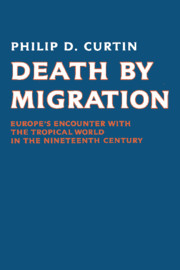Book contents
- Frontmatter
- Contents
- List of Tables, Figures, and Maps
- Preface
- List of Abbreviations
- 1 The Mortality Revolution and the Tropical World: Relocation Costs in the Early Nineteenth Century
- 2 Sanitation and Tropical Hygiene at Midcentury
- 3 Killing Diseases of the Tropical World
- 4 Relocation Costs in the Late Nineteenth Century
- 5 The Revolution in Hygiene and Tropical Medicine
- 6 The Pursuit of Disease, 1870–1914
- Conclusion
- Appendix Statistical Tables
- Bibliography
- Index
5 - The Revolution in Hygiene and Tropical Medicine
Published online by Cambridge University Press: 29 March 2010
- Frontmatter
- Contents
- List of Tables, Figures, and Maps
- Preface
- List of Abbreviations
- 1 The Mortality Revolution and the Tropical World: Relocation Costs in the Early Nineteenth Century
- 2 Sanitation and Tropical Hygiene at Midcentury
- 3 Killing Diseases of the Tropical World
- 4 Relocation Costs in the Late Nineteenth Century
- 5 The Revolution in Hygiene and Tropical Medicine
- 6 The Pursuit of Disease, 1870–1914
- Conclusion
- Appendix Statistical Tables
- Bibliography
- Index
Summary
The climate of a country has a most important influence on the health and character of its inhabitants. It therefore requires careful study by those who, having previously lived in temperate zones, are suddenly transferred to a tropical country: and whose very change of environment necessitates a perfect knowledge of many rules and precautions, if they desire to maintain a standard of health at all commensurate with what they naturally expect to enjoy at home: as well as to ward off those diseases, the result of deteriorations of the functions of the body, which are the effect produced by long residence in tropical countries.
J. Lane Notter, “Hygiene in the Tropics”From the 1870s to the 1890s, military medicine, tropical medicine, and tropical hygiene experienced a revolutionary change. At core of the revolution was the germ theory of Robert Koch, Louis Pasteur, and other microbiologists, but the theory itself grew out of a new attitude toward experimentation – toward the systematic collection and dissemination of knowledge.
The growing body of knowledge led to a stream of manuals giving practical advice, each appearing in new editions every few years. For India, the base was James Johnson's, Influences of Tropical Climates on European Constitutions (1813). James Ranald Martin joined as coauthor in 1841, then as sole author of the revised edition in 1859, and still another in 1861. William James Moore's Manual of the Diseases of India began a new series in 1861. New authors and new editions appeared in 1886, 1889, 1893, 1903, some with a subvention from the government of India.
- Type
- Chapter
- Information
- Death by MigrationEurope's Encounter with the Tropical World in the Nineteenth Century, pp. 104 - 129Publisher: Cambridge University PressPrint publication year: 1989



